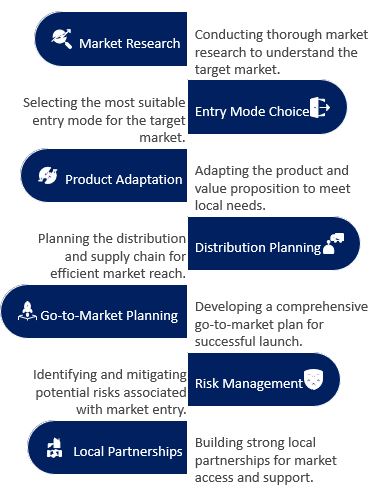Market Entry Strategy
Market entry strategy focuses on identifying the most effective approach to launch products or services in new regions. It includes evaluating entry modes, regulatory landscapes, local consumer behavior, and partnership opportunities. This enables businesses to minimize risks, tailor offerings, and establish a strong initial footprint in unfamiliar territories.

A market entry strategy outlines how a business will introduce its products or services to a new market, whether that’s a new country, region, or customer segment. It is a combination of research, strategic planning, resource alignment, and risk management, all carefully designed to position the organization for success in unfamiliar territory. Crafting a market entry strategy is a critical part of scaling a venture—it determines the tempo of growth, level of risk, and long-term sustainability in the target market.

The journey begins with thorough market research. Before making any moves, businesses must deeply understand the local landscape: customer preferences, demand patterns, cultural nuances, regulatory frameworks, competitors, and supply chain dynamics. This research helps to identify not just the size or attractiveness of the market, but also its hidden obstacles and unique opportunities. Companies study macroeconomic factors, industry trends, and consumer behaviors, while also mapping out local competitors and potential partners. Cultural fit is especially vital—missteps in adapting to local values or consumer habits have derailed many well-intended market entries.
Armed with insights, the organization must then select the best entry mode for its specific situation. There are several established approaches, each with distinct advantages and challenges. Exporting enables businesses to test markets with relatively low commitment, shipping goods directly from their home base to customers or distributors. Licensing and franchising allow companies to leverage local partners’ market knowledge, offering intellectual property or business models for a fee or share of revenue. Joint ventures involve sharing risks and rewards with a local partner, a choice sometimes mandated by regulatory requirements or pursued to gain distribution power and credibility. In cases where control is paramount, establishing a local subsidiary—either by setting up operations from scratch or acquiring an established player—can deliver full strategic oversight at the cost of higher risk and investment.
The choice of entry mode depends on a combination of internal capabilities, market conditions, risk appetite, and longer-term goals. A multinational might initially export to test demand before committing to a joint venture or direct investment. A technology firm weighing regulatory or intellectual property risks might emphasize licensing or controlled partnerships. Local laws and foreign ownership rules are also decisive; some industries or countries limit certain entry modes, nudging firms towards partnerships or minority stakes.
Product and value proposition adaptation is often necessary. Rarely can a company succeed by simply transplanting a home-market offering. Different markets might call for altered product features, packaging, pricing, or marketing strategies. Localizing the product to align with climate, cultural preferences, legal requirements, or consumption habits often drives adoption and loyalty. The same principle applies to branding and messaging—language, symbolism, and communication channels must match those of the new market.
Distribution and supply chain planning are crucial components of market entry execution. Businesses need to establish how they will get products or services into customers’ hands: via direct sales, local distributors, e-commerce platforms, retail partnerships, or a combination. Logistics—such as warehousing, shipping networks, payment systems, after-sales support—may require forming alliances with local service providers or investing in infrastructure. Digital businesses must consider local regulatory compliance for data, cybersecurity, and online payments.
Effective go-to-market planning underpins any entry strategy. This includes marketing, advertising, public relations, and sales tactics aligned with both product and target audience. Early success often hinges on building trust and awareness among local consumers and stakeholders. Companies may employ local talent and expertise to bridge cultural gaps, run pilot campaigns, or tap into influencer or community networks. Ongoing feedback and adaptability are essential: the realities on the ground often differ from initial plans, making early responsiveness and flexibility decisive for survival and growth.
Risk management lies at the heart of every market entry strategy. Entering a new market exposes a business to financial, regulatory, cultural, operational, and reputational risks. These might include volatile exchange rates, political instability, compliance failures, shifts in demand, or challenges in managing a dispersed team. Proactive risk assessment and contingency planning—such as insurance measures, local legal counsel, or phased rollouts—help to mitigate threats.
Building local partnerships can accelerate and de-risk market entry. Collaborating with established distributors, suppliers, agencies, or even competitors may open doors, facilitate regulatory approvals, and provide instant credibility. Partnerships also foster local knowledge transfer, increase speed to market, and lower investment burden, especially in unfamiliar or high-barrier environments.
In summary, the success of a market entry strategy depends on depth of preparation, clarity of objectives, local adaptation, and operational agility. It blends research, choice of entry mode, product and marketing adaptation, supply chain planning, risk management, and the leveraging of local alliances. Companies that view market entry as a dynamic, iterative process—rather than a one-off event—stand the best chance of capturing value and building lasting positions in new territories.
Company
Newsletter
We have a dedicated team of specialists for you as your email.


